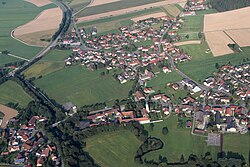Schönthal
Schönthal | |
|---|---|
 Aerial view | |
Location of Schönthal within Cham district  | |
| Coordinates: 49°21′N 12°36′E / 49.350°N 12.600°E | |
| Country | Germany |
| State | Bavaria |
| Admin. region | Oberpfalz |
| District | Cham |
| Government | |
| • Mayor (2020–26) | Ludwig Wallinger[1] (CSU) |
| Area | |
• Total | 43.70 km2 (16.87 sq mi) |
| Elevation | 453 m (1,486 ft) |
| Population (2023-12-31)[2] | |
• Total | 1,971 |
| • Density | 45/km2 (120/sq mi) |
| Time zone | UTC+01:00 (CET) |
| • Summer (DST) | UTC+02:00 (CEST) |
| Postal codes | 93488 |
| Dialling codes | 0 99 78 |
| Vehicle registration | CHA |
| Website | www.gemeinde-schoenthal.de |
Schönthal is a municipality in the district of Cham in Bavaria in Germany.
It was formerly the location of Schönthal Priory, secularised in 1802.
History
[edit]Until the foundation of the community
[edit]Schönthal belonged to the Schönthal Monastery, founded before the year 1263.
In 1433, the Battle of Hiltersried took place near Schönthal, in which John of Palatinate-Neumarkt drove the Hussites out of the Upper Palatinate.
Monasteries, offices and the population often waged legal wars against each other. The nursing office Rötz v. Schönthal Monastery: April 10, 1794, September 11, 1794, January 1, 1795, January 22, 1795, July 22, 1798 (der Schmid v. the monastery), September 17, 1798 (community v. the monastery.,[3] When the Upper Palatinate regional courts were filled with former monastic judges in 1803, the monastic judge Merz von Schönthal, among others, could not be taken over. Reason: "inept subjects".[4]
The place was later part of the Electorate of Bavaria and formed a closed Hofmark of the monastery, which was dissolved in 1802 in the course of secularization.
References
[edit]- ^ Liste der ersten Bürgermeister/Oberbürgermeister in kreisangehörigen Gemeinden, Bayerisches Landesamt für Statistik, 15 July 2021.
- ^ Genesis Online-Datenbank des Bayerischen Landesamtes für Statistik Tabelle 12411-003r Fortschreibung des Bevölkerungsstandes: Gemeinden, Stichtag (Einwohnerzahlen auf Grundlage des Zensus 2011).
- ^ digiPress: Churfürstlich gnädigst privilegirtes oberpfälzisch-staatistisches Wochenblat (Oberpfälzisches Wochenblat) vom 1.) 10. April 1794, 2.) Donnerstag, dem 11. September 1794 (digitale-sammlungen.de); 3.) 22. Januar 1795, 4.) 2. August 1798. 5.) 27. September 1798
- ^ Die Protokolle des Bayerischen Staatsrats 1799 bis 1817 Herausgegeben von der Historischen Kommission bei der Bayerischen Akademie der Wissenschaften durch Eberhard Weis und von der Generaldirektion der Staatlichen Archive Bayerns durch Hermann Rumschöttel, Band 2, 1802 bis 1807 Bearbeitet von Esteban Mauerer, München 2008, S. 595f




